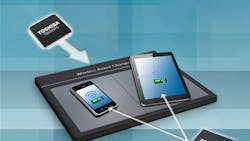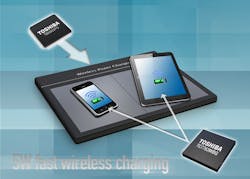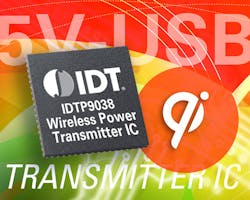Inductive technology is making rapid inroads into wireless charging, serving anything from the passenger buses currently running in the UK city of Milton Keynes to mobile phones. Inductive charging is based on the principles of electromagnetic (EM) coupling. The chargers use an induction coil to create an alternating EM field from a charging base station. A second coil, which is embedded in a portable device, receives power from the EM field and converts it into electrical current. That current can power the device receiving the current and charge its battery. To support the expected growth of this novel technology, solutions ranging from transmitters and receivers to integrated circuits (ICs) are now being developed at a rapid pace.
This file type includes high resolution graphics and schematics when applicable.
In a recent development, for example, Dusseldorf-based Toshiba Europe enhanced its TB6865FG power transmitter and TC7763WBG receiver chipset. According to the company, these solutions enable mobile devices to be charged more quickly. The receiver chipset, which can now handle 5-W power transfers, is compatible with the Qi Standard Low Power Specifications version 1.1. Features include foreign-object detection and an integrated digital logic controller, which reduces component count while simplifying design complexity. The recently announced TC7761WBG IC has been awarded Qi certification for 3.5-W output power.
Built with Toshiba’s mixed-signal process, the TB6865FG integrates a microcontroller (MCU) that can drive four external MOSFET H Bridges of four coils (Fig. 1). The result is a free-positioning architecture supporting two mobile devices. The TC7763WBG receiver combines modulation and control circuitry with a rectifier power pickup, built-in linear dropout regulator, and circuit-protection functions.
Another Qi-compliant, single-chip, wireless power transmitter hails from Integrated Device Technology (IDT). According to the company, the IDTP9038 is the first transmitter to support a 5-V input (Fig. 2). The company also claims that the device enables the development of USB-powered wireless-charging bases using 75% less integrated circuits than other solutions. This single-chip, wireless-power transmitter IC is compatible with the Wireless Power Consortium (WPC) 1.1 Qi standard for A5 and A11 coil configurations. Thus, the IDTP9038 allows designers to develop charging bases compatible with any Qi-compliant portable device.
In addition to Qi compliance, the IDTP9038 device boasts an embedded microcontroller and integrated full-bridge inverter with low-resistance field-effect transistors (FETs). Those FETs enable high-efficiency power transfer. A high-power transfer mode, which can supposedly deliver up to 60% more power than what is specified by the Qi standard, transmits up to 8 W of power when paired with an IDT wireless power receiver. The 5-V IDTP9038 features USB connectivity.
Get To Know Qi
The Qi interface standard was developed by the Wireless Power Consortium (WPC) for inductive electrical power transfer over distances to 4 cm. The WPC is an open-membership cooperation spanning companies in Asia, Europe, and America. The Qi system consists of a power transmission pad and a compatible receiver in the recipient device.
The Qi specification defines low power for inductive transfer as being a draw of 0 to 5 W. The systems that fall within the standard’s scope use inductive coupling between two planar coils to transfer power from the power transmitter to the power receiver. Precise control of the output voltage is provided by a digital control loop. Here, the power receiver communicates with the power transmitter and requests more or less power. Communication is unidirectional from the power receiver to the power transmitter via backscatter modulation. The power-receiver coil is loaded, changing the current draw at the power transmitter.
This file type includes high resolution graphics and schematics when applicable.
About the Author
Paul Whytock
Editor-in-Chief
Paul Whytock is European Editor for Microwaves & RF and European Editor-in-Chief for Electronic Design. He reports on the latest news and technology developments in Europe for his US readers while providing his European engineering audience with global news coverage from the electronics sector. Trained originally as a design engineer with Ford Motor Co., Whytock holds an HNC in mechanical, electrical, and production engineering.



